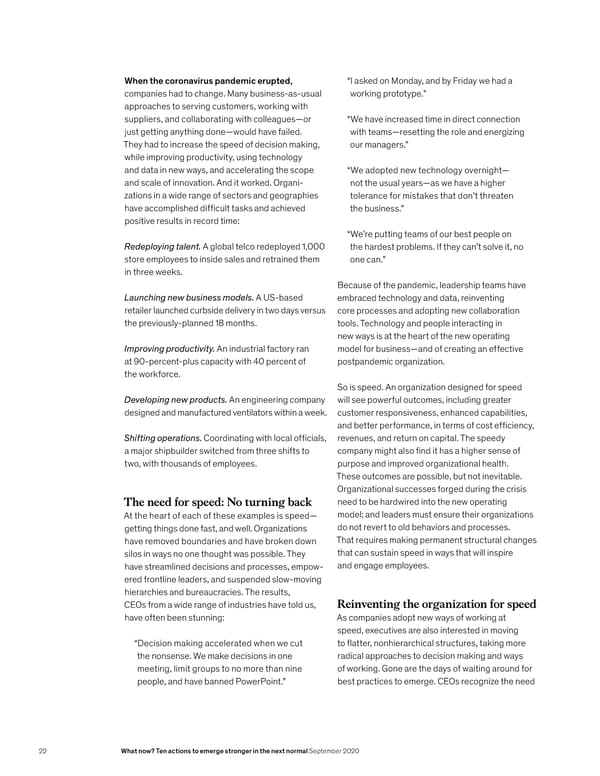When the coronavirus pandemic erupted, “I asked on Monday, and by Friday we had a companies had to change. Many business-as-usual working prototype.” approaches to serving cus tomers, working with suppliers, and collaborating with colleagues—or “We have increased time in direct connection just getting anything done—would have failed. with teams—resetting the role and energizing They had to increase the speed of decision making, our managers.” while improving productivity, using technology and data in new ways, and acceler ating the scope “We adopted new technology overnight— and scale of innovation. And it worked. Organi- not the usual years—as we have a higher zations in a wide range of sectors and geographies tolerance for mistakes that don’t threaten have accomplished difficult tasks and achieved the business.” positive results in record time: “We’re putting teams of our best people on Redeploying talent. A global telco redeployed 1,000 the hardest problems. If they can’t solve it, no store employees to inside sales and retrained them one can.” in three weeks. Because of the pandemic, leadership teams have Launching new business models. A US-based embraced technology and data, reinventing retailer launched curbside delivery in two days versus core processes and adopting new collaboration the previously-planned 18 months. tools. Technology and people interacting in new ways is at the heart of the new operating Improving productivity. An industrial factory ran model for business—and of creating an effective at 90-percent-plus capacity with 40 percent of postpandemic organization. the workforce. So is speed. An organization designed for speed Developing new products. An engineering company will see powerful outcomes, including greater designed and manufactured ventilators within a week. customer responsiveness, enhanced capabilities, and better performance, in terms of cost efficiency, Shifting operations. Coordinating with local officials, revenues, and return on capital. The speedy a major shipbuilder switched from three shifts to company might also find it has a higher sense of two, with thousands of employees. purpose and improved organizational health. These outcomes are possible, but not inevitable. Organizational successes forged during the crisis The need for speed: No turning back need to be hardwired into the new operating At the heart of each of these examples is speed— model; and leaders must ensure their organizations getting things done fast, and well. Organizations do not revert to old behaviors and processes. have removed boundaries and have broken down That requires making permanent structural changes silos in ways no one thought was possible. They that can sustain speed in ways that will inspire have streamlined decisions and processes, empow- and engage employees. ered frontline leaders, and suspended slow-moving hierarchies and bureaucracies. The results, CEOs from a wide range of industries have told us, Reinventing the organization for speed have often been stunning: As companies adopt new ways of working at speed, executives are also interested in moving “Decision making accelerated when we cut to flatter, nonhierarchical structures, taking more the nonsense. We make decisions in one radical approaches to decision making and ways meeting, limit groups to no more than nine of working. Gone are the days of waiting around for people, and have banned PowerPoint.” best practices to emerge. CEOs recognize the need 22 What now? Ten actions to emerge stronger in the next normal September 2020
 What Now? Page 23 Page 25
What Now? Page 23 Page 25